FNSACC507 - Sydney Metro College: Management Accounting Assignment
VerifiedAdded on 2023/06/04
|26
|2345
|357
Homework Assignment
AI Summary
This assignment solution covers various aspects of management accounting, including cost accounting systems, manufacturing statements, inventory valuation methods (FIFO and weighted average), journal entries, variance analysis, budgeting, and break-even point calculations. It addresses tasks such as calculating the cost of goods manufactured and sold, preparing manufacturing and trading statements, analyzing variances in expenditures, and determining break-even points for sales and production. The document also includes practical applications with numerical examples and journal entries to demonstrate accounting principles and techniques relevant to manufacturing and service industries.
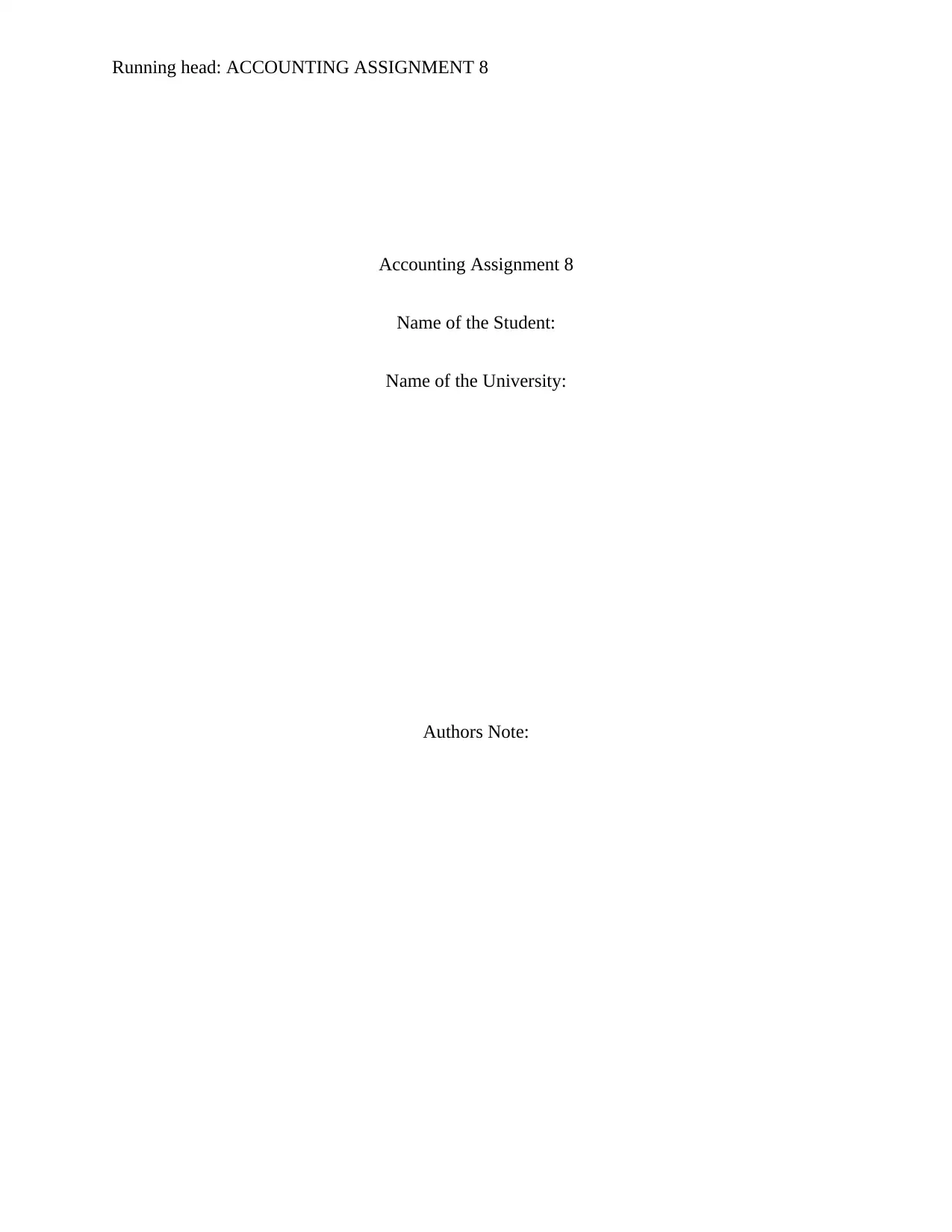
Running head: ACCOUNTING ASSIGNMENT 8
Accounting Assignment 8
Name of the Student:
Name of the University:
Authors Note:
Accounting Assignment 8
Name of the Student:
Name of the University:
Authors Note:
Paraphrase This Document
Need a fresh take? Get an instant paraphrase of this document with our AI Paraphraser

1ACCOUNTING ASSIGNMENT 8
Contents
Task 1:.............................................................................................................................................2
Task 2:.............................................................................................................................................4
References:....................................................................................................................................25
Contents
Task 1:.............................................................................................................................................2
Task 2:.............................................................................................................................................4
References:....................................................................................................................................25
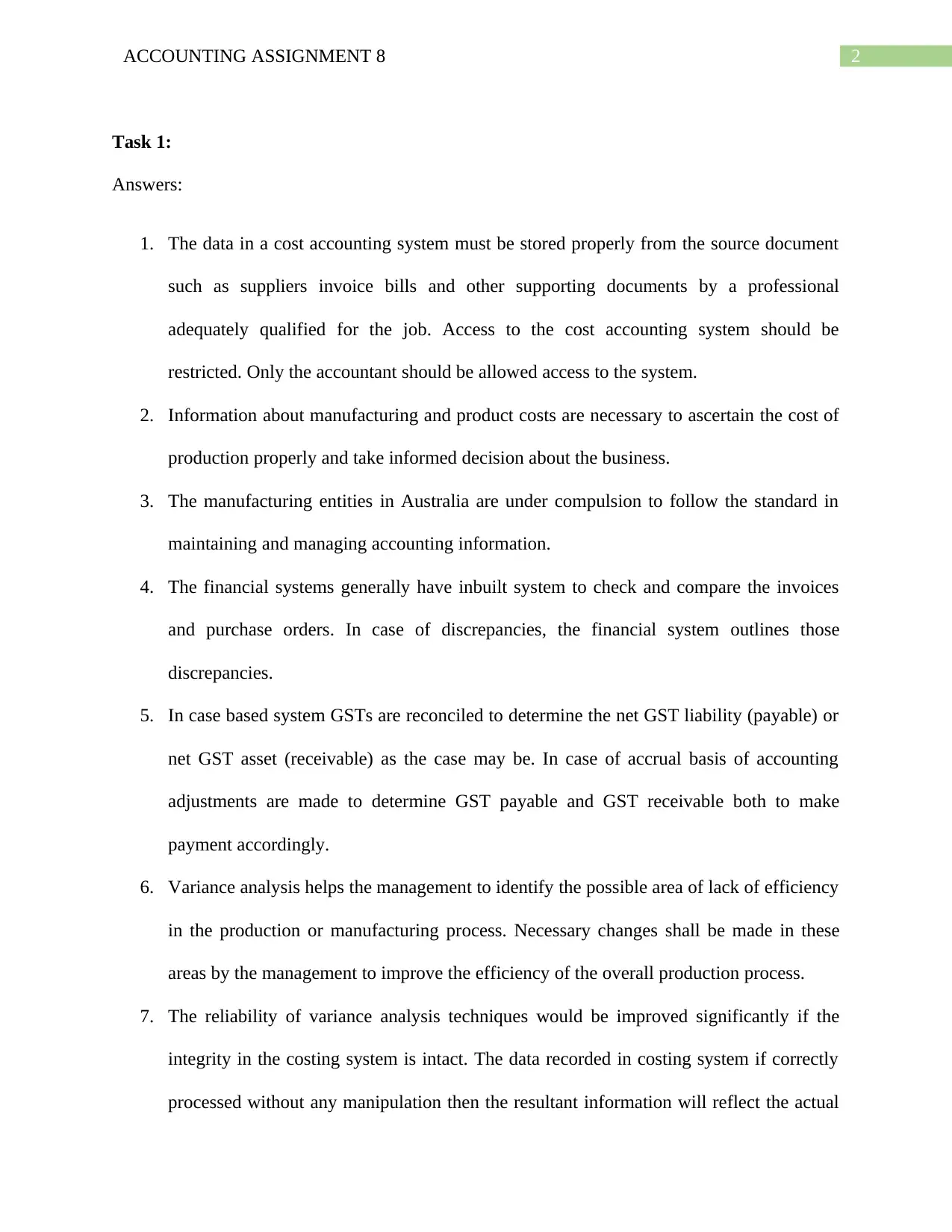
2ACCOUNTING ASSIGNMENT 8
Task 1:
Answers:
1. The data in a cost accounting system must be stored properly from the source document
such as suppliers invoice bills and other supporting documents by a professional
adequately qualified for the job. Access to the cost accounting system should be
restricted. Only the accountant should be allowed access to the system.
2. Information about manufacturing and product costs are necessary to ascertain the cost of
production properly and take informed decision about the business.
3. The manufacturing entities in Australia are under compulsion to follow the standard in
maintaining and managing accounting information.
4. The financial systems generally have inbuilt system to check and compare the invoices
and purchase orders. In case of discrepancies, the financial system outlines those
discrepancies.
5. In case based system GSTs are reconciled to determine the net GST liability (payable) or
net GST asset (receivable) as the case may be. In case of accrual basis of accounting
adjustments are made to determine GST payable and GST receivable both to make
payment accordingly.
6. Variance analysis helps the management to identify the possible area of lack of efficiency
in the production or manufacturing process. Necessary changes shall be made in these
areas by the management to improve the efficiency of the overall production process.
7. The reliability of variance analysis techniques would be improved significantly if the
integrity in the costing system is intact. The data recorded in costing system if correctly
processed without any manipulation then the resultant information will reflect the actual
Task 1:
Answers:
1. The data in a cost accounting system must be stored properly from the source document
such as suppliers invoice bills and other supporting documents by a professional
adequately qualified for the job. Access to the cost accounting system should be
restricted. Only the accountant should be allowed access to the system.
2. Information about manufacturing and product costs are necessary to ascertain the cost of
production properly and take informed decision about the business.
3. The manufacturing entities in Australia are under compulsion to follow the standard in
maintaining and managing accounting information.
4. The financial systems generally have inbuilt system to check and compare the invoices
and purchase orders. In case of discrepancies, the financial system outlines those
discrepancies.
5. In case based system GSTs are reconciled to determine the net GST liability (payable) or
net GST asset (receivable) as the case may be. In case of accrual basis of accounting
adjustments are made to determine GST payable and GST receivable both to make
payment accordingly.
6. Variance analysis helps the management to identify the possible area of lack of efficiency
in the production or manufacturing process. Necessary changes shall be made in these
areas by the management to improve the efficiency of the overall production process.
7. The reliability of variance analysis techniques would be improved significantly if the
integrity in the costing system is intact. The data recorded in costing system if correctly
processed without any manipulation then the resultant information will reflect the actual
⊘ This is a preview!⊘
Do you want full access?
Subscribe today to unlock all pages.

Trusted by 1+ million students worldwide

3ACCOUNTING ASSIGNMENT 8
costing of a manufacturing and production organization. Thus the variance analysis will
also be improved as the data will be authentic and correct (Dekker, 2016).
8. Budgets are prepared to achieve organization objectives. Comparison of actual financial
performance of an organization with its budgeted performance further helps the
management to evaluate the efficiency of an organization in achieving its objectives.
9. Three objectives of budgets are as following:
a. Evaluation of performance.
b. Optimum utilization of resources.
c. Minimizing cost of productions.
10. Three sources to gather information are as following:
a. Historic financial statements.
b. Board of directors’ report.
c. Proposed agreement documents.
11. The principle of double entry system of accounting is that there would be equal liabilities
and assets after each financial transaction as there is always compensating effects on
wealth and liabilities for the double entry system of accounting of each and every
financial transaction.
Accrual based accounting is on the basis of earning and incurred concept rather
than receipts and payments. Thus, revenue is recognized when earned even if not
received and expenditures are recognized when incurred even if not paid (Otley,
2016).
12. The following is on the basis of actual components:
a. Raw materials.
costing of a manufacturing and production organization. Thus the variance analysis will
also be improved as the data will be authentic and correct (Dekker, 2016).
8. Budgets are prepared to achieve organization objectives. Comparison of actual financial
performance of an organization with its budgeted performance further helps the
management to evaluate the efficiency of an organization in achieving its objectives.
9. Three objectives of budgets are as following:
a. Evaluation of performance.
b. Optimum utilization of resources.
c. Minimizing cost of productions.
10. Three sources to gather information are as following:
a. Historic financial statements.
b. Board of directors’ report.
c. Proposed agreement documents.
11. The principle of double entry system of accounting is that there would be equal liabilities
and assets after each financial transaction as there is always compensating effects on
wealth and liabilities for the double entry system of accounting of each and every
financial transaction.
Accrual based accounting is on the basis of earning and incurred concept rather
than receipts and payments. Thus, revenue is recognized when earned even if not
received and expenditures are recognized when incurred even if not paid (Otley,
2016).
12. The following is on the basis of actual components:
a. Raw materials.
Paraphrase This Document
Need a fresh take? Get an instant paraphrase of this document with our AI Paraphraser
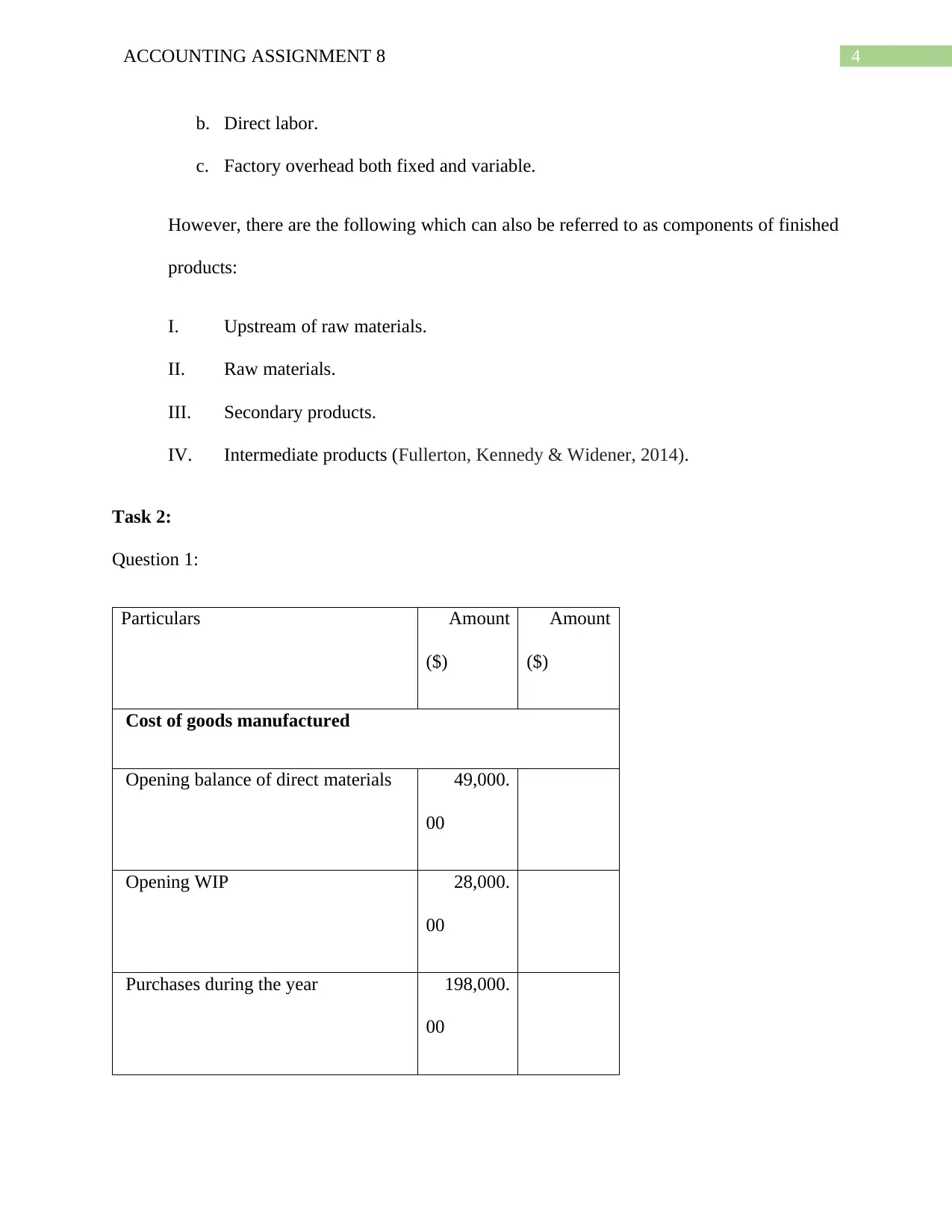
4ACCOUNTING ASSIGNMENT 8
b. Direct labor.
c. Factory overhead both fixed and variable.
However, there are the following which can also be referred to as components of finished
products:
I. Upstream of raw materials.
II. Raw materials.
III. Secondary products.
IV. Intermediate products (Fullerton, Kennedy & Widener, 2014).
Task 2:
Question 1:
Particulars Amount
($)
Amount
($)
Cost of goods manufactured
Opening balance of direct materials 49,000.
00
Opening WIP 28,000.
00
Purchases during the year 198,000.
00
b. Direct labor.
c. Factory overhead both fixed and variable.
However, there are the following which can also be referred to as components of finished
products:
I. Upstream of raw materials.
II. Raw materials.
III. Secondary products.
IV. Intermediate products (Fullerton, Kennedy & Widener, 2014).
Task 2:
Question 1:
Particulars Amount
($)
Amount
($)
Cost of goods manufactured
Opening balance of direct materials 49,000.
00
Opening WIP 28,000.
00
Purchases during the year 198,000.
00

5ACCOUNTING ASSIGNMENT 8
Direct labour costs incurred 205,000.
00
Manufacturing overhead 173,000.
00
653,000.
00
Less:
Closing balance of direct materials 42,000.
00
Closing balance of WIP 30,000.
00
72,000.
00
Cost of goods manufactured 581,000.
00
Cost of goods sold
Cost of goods manufactured 581,000.
00
Direct labour costs incurred 205,000.
00
Manufacturing overhead 173,000.
00
653,000.
00
Less:
Closing balance of direct materials 42,000.
00
Closing balance of WIP 30,000.
00
72,000.
00
Cost of goods manufactured 581,000.
00
Cost of goods sold
Cost of goods manufactured 581,000.
00
⊘ This is a preview!⊘
Do you want full access?
Subscribe today to unlock all pages.

Trusted by 1+ million students worldwide

6ACCOUNTING ASSIGNMENT 8
Add: Opening finished goods 80,000.
00
501,000.
00
Less: Closing finished goods 76,000.
00
Cost of goods sold 425,000.
00
Question 2:
Manufacturing statement
Particulars $ $
Opening direct materials 7,000
.00
Opening WIP 9,600
.00
Purchases 42,300
.00
Add: Opening finished goods 80,000.
00
501,000.
00
Less: Closing finished goods 76,000.
00
Cost of goods sold 425,000.
00
Question 2:
Manufacturing statement
Particulars $ $
Opening direct materials 7,000
.00
Opening WIP 9,600
.00
Purchases 42,300
.00
Paraphrase This Document
Need a fresh take? Get an instant paraphrase of this document with our AI Paraphraser
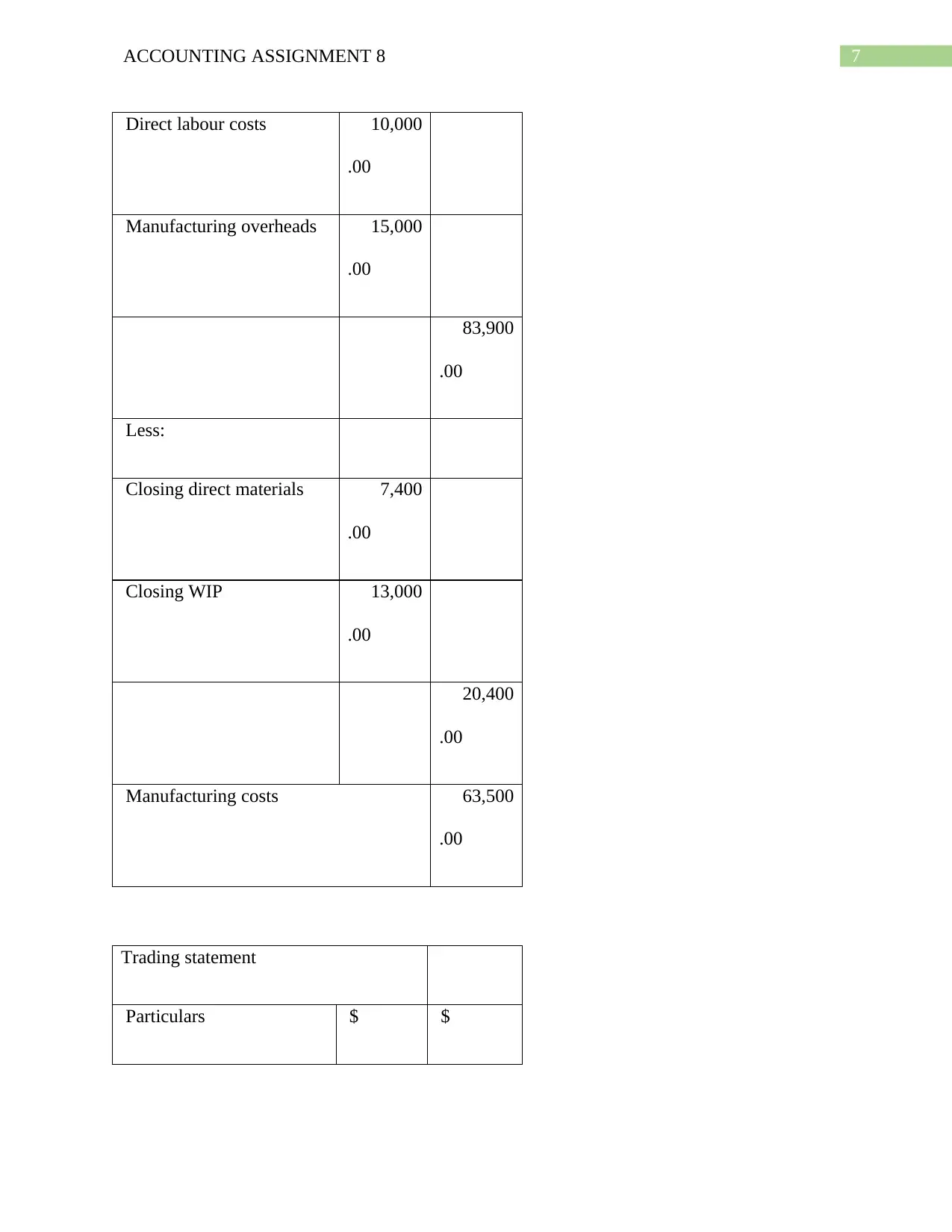
7ACCOUNTING ASSIGNMENT 8
Direct labour costs 10,000
.00
Manufacturing overheads 15,000
.00
83,900
.00
Less:
Closing direct materials 7,400
.00
Closing WIP 13,000
.00
20,400
.00
Manufacturing costs 63,500
.00
Trading statement
Particulars $ $
Direct labour costs 10,000
.00
Manufacturing overheads 15,000
.00
83,900
.00
Less:
Closing direct materials 7,400
.00
Closing WIP 13,000
.00
20,400
.00
Manufacturing costs 63,500
.00
Trading statement
Particulars $ $
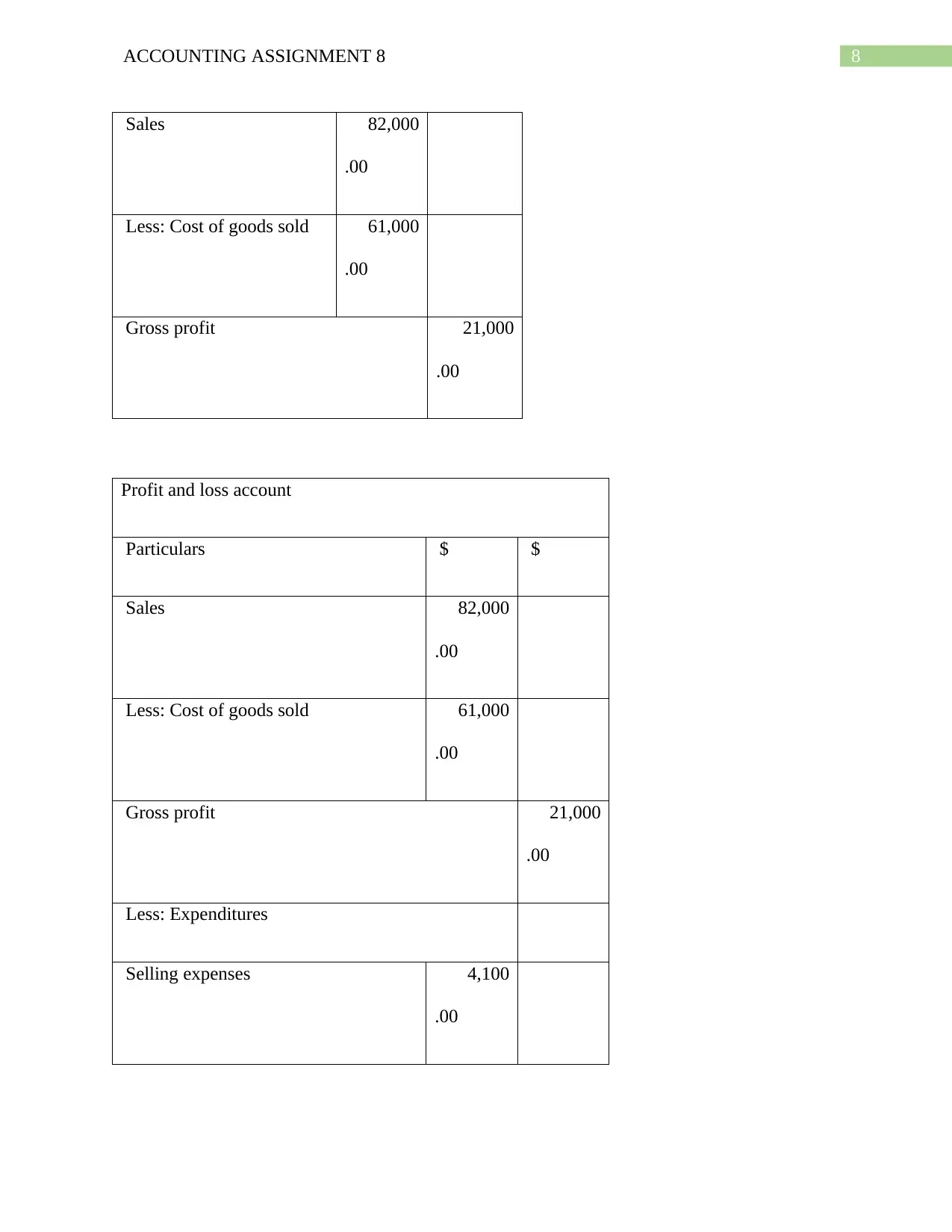
8ACCOUNTING ASSIGNMENT 8
Sales 82,000
.00
Less: Cost of goods sold 61,000
.00
Gross profit 21,000
.00
Profit and loss account
Particulars $ $
Sales 82,000
.00
Less: Cost of goods sold 61,000
.00
Gross profit 21,000
.00
Less: Expenditures
Selling expenses 4,100
.00
Sales 82,000
.00
Less: Cost of goods sold 61,000
.00
Gross profit 21,000
.00
Profit and loss account
Particulars $ $
Sales 82,000
.00
Less: Cost of goods sold 61,000
.00
Gross profit 21,000
.00
Less: Expenditures
Selling expenses 4,100
.00
⊘ This is a preview!⊘
Do you want full access?
Subscribe today to unlock all pages.

Trusted by 1+ million students worldwide

9ACCOUNTING ASSIGNMENT 8
General and administratuve expenses 2,900
.00
7,000
.00
Profit before tax 14,000
.00
Less: Tax @30% 4,200
.00
Net profit 9,800
.00
Question 3:
FIFO:
In
Cost
Units Per Total Units
Unit
$ $ $
200 7.2 1440 1440
160 7.4 1184
290
260 8 2080
110
1760
Issues 220 8 1760
Purchases 330 2598
Issues 2106 70 7.4 518
Purchases 360 2624
$ $ $
Balance 200 7.2
unit unit
Details per Total Units per Total
Cost Cost
i) Perpetual inventory system
Out Balance
Periodic System $
General and administratuve expenses 2,900
.00
7,000
.00
Profit before tax 14,000
.00
Less: Tax @30% 4,200
.00
Net profit 9,800
.00
Question 3:
FIFO:
In
Cost
Units Per Total Units
Unit
$ $ $
200 7.2 1440 1440
160 7.4 1184
290
260 8 2080
110
1760
Issues 220 8 1760
Purchases 330 2598
Issues 2106 70 7.4 518
Purchases 360 2624
$ $ $
Balance 200 7.2
unit unit
Details per Total Units per Total
Cost Cost
i) Perpetual inventory system
Out Balance
Periodic System $
Paraphrase This Document
Need a fresh take? Get an instant paraphrase of this document with our AI Paraphraser

10ACCOUNTING ASSIGNMENT 8
Opening stock: raw material at beginning 200 1440
Add: purchases 160 1184
Total material available 360 2624
Less: closing stock – raw material at end 220 1760
Raw material used 140 864
Calculation of closing stock: 220 1760
Weighted average cost under a perpetual system:
i) Perpetual inventory system
In Out Balance
Cos
t
Cost Cost
Details Unit
s
Per Tota
l
Unit
s
per Total Unit
s
per Total
Unit unit unit
$ $ $ $ $ $
Balance 200 7.2 1440 200 7.2 1440
Opening stock: raw material at beginning 200 1440
Add: purchases 160 1184
Total material available 360 2624
Less: closing stock – raw material at end 220 1760
Raw material used 140 864
Calculation of closing stock: 220 1760
Weighted average cost under a perpetual system:
i) Perpetual inventory system
In Out Balance
Cos
t
Cost Cost
Details Unit
s
Per Tota
l
Unit
s
per Total Unit
s
per Total
Unit unit unit
$ $ $ $ $ $
Balance 200 7.2 1440 200 7.2 1440
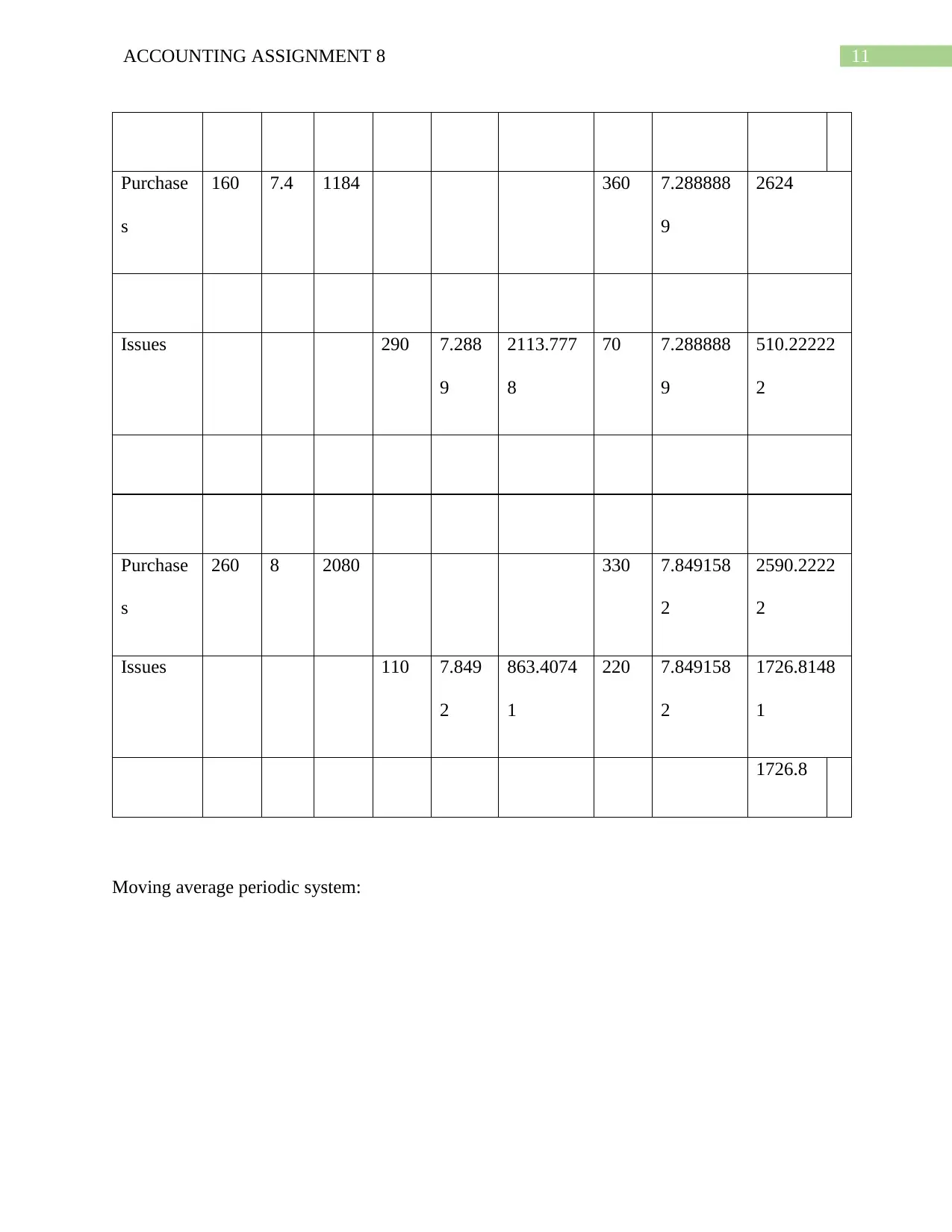
11ACCOUNTING ASSIGNMENT 8
Purchase
s
160 7.4 1184 360 7.288888
9
2624
Issues 290 7.288
9
2113.777
8
70 7.288888
9
510.22222
2
Purchase
s
260 8 2080 330 7.849158
2
2590.2222
2
Issues 110 7.849
2
863.4074
1
220 7.849158
2
1726.8148
1
1726.8
Moving average periodic system:
Purchase
s
160 7.4 1184 360 7.288888
9
2624
Issues 290 7.288
9
2113.777
8
70 7.288888
9
510.22222
2
Purchase
s
260 8 2080 330 7.849158
2
2590.2222
2
Issues 110 7.849
2
863.4074
1
220 7.849158
2
1726.8148
1
1726.8
Moving average periodic system:
⊘ This is a preview!⊘
Do you want full access?
Subscribe today to unlock all pages.

Trusted by 1+ million students worldwide
1 out of 26
Related Documents
Your All-in-One AI-Powered Toolkit for Academic Success.
+13062052269
info@desklib.com
Available 24*7 on WhatsApp / Email
![[object Object]](/_next/static/media/star-bottom.7253800d.svg)
Unlock your academic potential
Copyright © 2020–2025 A2Z Services. All Rights Reserved. Developed and managed by ZUCOL.



